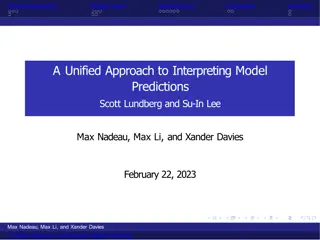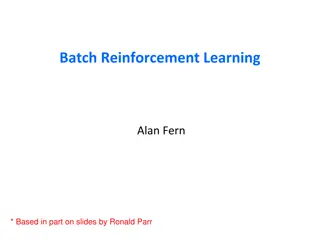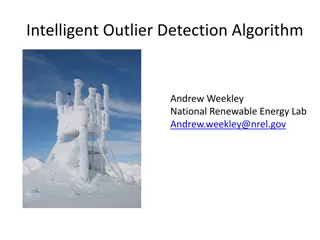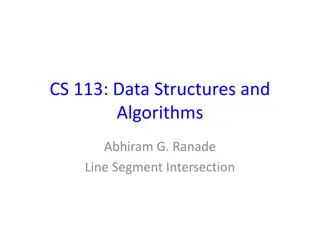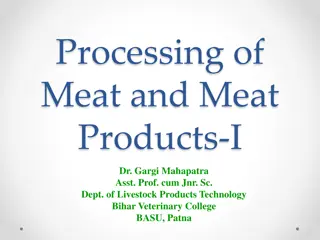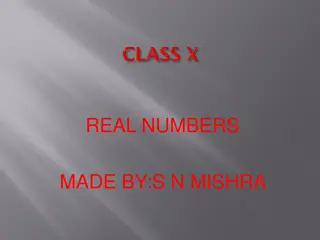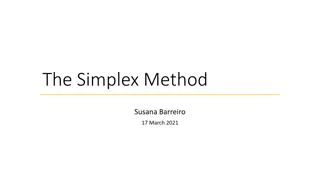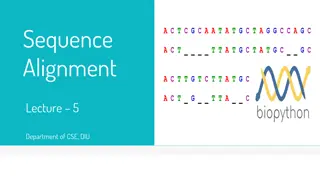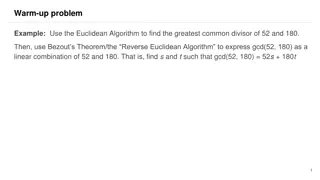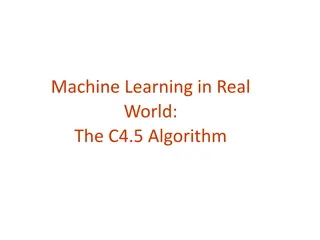Understanding Stable Matchings and the Gale-Shapley Algorithm
The concept of stable matchings is explored, along with the Gale-Shapley algorithm for finding them efficiently. Key ideas and steps of the algorithm are explained, supported by visuals. The process, examples, and observations related to the algorithm's effectiveness are discussed, highlighting the importance of invariants and progress measures.
Download Presentation

Please find below an Image/Link to download the presentation.
The content on the website is provided AS IS for your information and personal use only. It may not be sold, licensed, or shared on other websites without obtaining consent from the author. Download presentation by click this link. If you encounter any issues during the download, it is possible that the publisher has removed the file from their server.
E N D
Presentation Transcript
Stable Matching Problem Given two sets R = ?1, ,??,? = { 1, , ?} each agent ranks every every agent in the other set. Goal: Match each agent to exactly one their preferences. How do we respect preferences ? Avoid blocking pairs: unmatched pairs (?, ) where ? prefers to their match, and prefers ? to its match. ? , exactly one agent in the other set, respecting ?,? ?
Stable Matching, More Formally Perfect matching: Each rider is paired with exactly one horse. Each horse is paired with exactly one rider. Stability: no ability to exchange an unmatched pair ?- is blocking if they both prefer each other to current matches. Stable matching: perfect matching with no blocking pairs. Stable Matching Problem Given: the preference lists of ? riders and ? horses. Find: a stable matching.
Questions Does a stable matching always exist? Can we find a stable matching efficiently? We ll answer both of those questions in the next few lectures. Let s start with the second one.
Idea for an Algorithm Key idea Unmatched riders propose to the highest horse on their preference list that they have not already proposed to. Send in a rider to walk up to their favorite horse. Everyone in front of a different horse? Done! If more than one rider is at the same horse, let the horse decide its favorite. Rejected riders go back outside. Repeat until you have a perfect matching.
Gale-Shapley Algorithm Initially all ? in ? and in ? are free While there is a free ? Let be highest on ? s list that ? has not proposed to if is free, then match (?, ) else // is not free suppose (? , ) are matched if prefers ? to r unmatch (? , ) match (?, )
Algorithm Example ?1 1 ?2 ,?3,?1 1 , 2, 3 ?2 2 1 , 3, 2 ?3 ,?1,?2 3 1 , 2, 3 ?3 ?3 ,?1,?2 Proposals: ?1,?2,?1,?3,?3,?1
Does this algorithm work? Does it run in a reasonable amount of time? Is the result correct (i.e. a stable matching)? Begin by identifying invariants and measures of progress Observation A: r s proposals get worse for them. Observation B: Once h is matched, h stays matched. Observation C: h s partners get better. How do we justify these? A one-sentence explanation would suffice for each of these on the homework. How did we know these were the right observations? Practice. And editing we wouldn t have found these the first time, but after reading through early proof attempts.
Claim 1: If ? proposed to the last horse on their list, then all the horses are matched. Try to prove this claim, i.e. clearly explain why it is true. You might want some of these observations: Observation A: r s proposals get worse for them. Observation B: Once h is matched, h stays matched. Observation C: h s partners get better. Hint: ? must have been rejected a lot what does that mean?
Claim 1: If ? proposed to the last horse on their list, then all the horses are matched. Hint: ? must have been rejected a lot what does that mean? By Observation B, once a horse receives any proposal it is not free for the rest of the algorithm. So every horse on ? s list must be matched. And every horse is on ? s list!
Claim 2: The algorithm stops after ? ?2 proposals. Hint: When do we exit the loop? (Use claim 1). If every horse is matched, every rider must be matched too. -Because each horse is matched to exactly one rider and there are an equal number of riders and horses. It takes at most ? ?2 proposals to get to the end of some rider s list. Claim 2 now follows from Claim 1. Question 1 answered: The algorithm halts (quickly)! Now question 2: does it produce a stable matching?
Wrapping up the running time We need ?(?2) proposals. But how many steps does the full algorithm execute? Depends on how we implement it we re going to need some data structures.
Gale-Shapley Algorithm Initially all ? in ? and in ? are free While there is a free ? Let be highest on ? s list that ? has not proposed to if is free, then match (?, ) else // is not free suppose (? , ) are matched if prefers ? to r unmatch (? , ) match (?, ) Are each of these operations really ?(1)? Assume that you get two int[][] with the preferences.
Gale-Shapley Algorithm Initially all ? in ? and in ? are free While there is a free ? Let be highest on ? s list that ? has not proposed to if is free, then match (?, ) else // is not free suppose (? , ) are matched if prefers ? to r unmatch (? , ) match (?, ) Are each of these operations really ?(1)? Assume that you get two int[][] with the preferences. Need to maintain free ?. What can insert and remove in ? 1 time? Each ? should know where it is on its list. Maintain partial matching Given two riders, which horse is preferred? Maintain partial matching
What data structures should you use? Initially all ? in ? and in ? are free While there is a free ? Let be highest on ? s list that ? has not proposed to if is free, then match (?, ) else // is not free suppose (? , ) are matched if prefers ? to r unmatch (? , ) match (?, ) Need to maintain free ?. What can insert and remove in ? 1 time? Each ? should know where it is on its list. Maintain partial matching Given two riders, which horse is preferred? Maintain partial matching Introduce yourselves! If you can turn your video on, please do. If you can t, please unmute and say hi. If you can t do either, say hi in chat. Choose someone to share screen, showing this pdf. Fill out the poll everywhere for Activity Credit! Go to pollev.com/cse417 and login with your UW identity
What data structures? Need to maintain free ?. What can insert and remove in ? 1 time? Queue, stack, or list (inserting at end) all would be fine. Maintain partial matching Two arrays (index i has number for partner of agent i. Each ? should know where it is on its list. int for each rider (likely store in an array) Given two riders, which is preferred? Lookup in int[][]takes ?(?) in the worst case. Uh-oh. Better idea: build inverse arrays (given rider, what is their rank One time cost of?(?2) time and space to build, but comparisons ?(1). rank for horse?).
What data structures? These aren t the only options you might decide on an object- based approach (can meet same time bounds up to constant factors) Need to maintain free ?. What can insert and remove in ? 1 time? Queue, stack, or list (inserting at end) all would be fine. Maintain partial matching But tl;dr: You really can get ?(?2) time! Two arrays (index i has number for partner of agent i. Each ? should know where it is on its list. int for each rider (likely store in an array) Given two riders, which is preferred? Lookup in int[][]takes ?(?) in the worst case. Uh-oh. Better idea: build inverse arrays (given rider, what is their rank One time cost of?(?2) time and space to build, but comparisons ?(1). rank for horse?).
Analyzing Gale-Shapley Efficient? Halts in ?(?2) steps. Works? Need a matching that s: Perfect Has no blocking pairs
Claim 3: The algorithm identifies a perfect matching. Why? We know the algorithm halts. Which means when it halts every rider is matched. But we have the same number of horses and riders, and we matched them one-to-one. Hence, the algorithm finds a perfect matching.
Claim 4: The matching has no blocking pairs. We want to prove a negative there is no blocking pair. That s a good sign for proof by contradiction. What s proof by contradiction? I want to know ? is true. Imagine, ? were false. Study the world that would result. Realize that world makes no sense (something false is true) But the real world does make sense! So ? must be true.
Claim 4: The matching has no blocking pairs. We want to prove a negative there is no blocking pair. That s a good sign for proof by contradiction. Suppose (for contradiction) that (?1, 1) and (?2, 2) are matched, but ?1prefers 2 to 1 and 2 prefers ?1 to ?2 ?1 1 2 1 ?2 2 ?1 ?2
Claim 4: The matching has no blocking pairs. ?1 1 2 1 ?2 2 ?1 ?2 How did ?1 end up matched to 1? He must have proposed to and been rejected by 2 (Observation A). Why did 2 reject ?1? It got a better offer from some r . If 2 ever changed matches after that, the match was only better for it, (Observation C) so it must prefer ?2 (its final match) to ?1. A contradiction!
Result Simple, ?(?2) algorithm to compute a stable matching Corollary A stable matching always exists. The corollary isn t obvious! The stable roommates problem doesn t always have a solution: 2? people, rank the other 2? 1 Goal is to pair them without any blocking pairs.
Multiple Stable Matchings Suppose we take our algorithm and let the horses do the proposing instead. ?1 1 ?2 ,?1 1 , 2 ?2 2 ?1 ,?2 2 , 1 We got a different answer What does that mean?
Proposer-Optimality Some agents might have more than one possible match in a stable matching. Call these people the feasible partners. When there s more than one stable matching, there is a tremendous benefit to being the proposing side. Proposer-Optimality Every member of the proposing side is matched to their favorite of their feasible partners.
Proposer-Optimality Proposer-Optimality Every member of the proposing side is matched to the favorite of their feasible partners. ? ? Let s prove it again by contradiction Suppose some rider is not matched to their favorite feasible partner. Then some ? must have been the first first to be rejected by their favorite feasible partner, . (Observation A) And there is an ? that (temporarily) matched to causing that rejection. Let ? be a matching where ?, are matched. The rider ? is matched to some . What can we say about ? ? They had never been rejected by a feasible partner. So they prefer to . And prefers ? to ? (by the run of the algorithm). But then (? , ) are a blocking pair in ? ! ? ?
Implications of Proposer Optimality Proposer-Optimality Every member of the proposing side is matched to their favorite of their feasible partners. We didn t specify which rider proposes when more than one is free Proposer-optimality says it doesn t matter! You always get the proposer-optimal matching. So what happens to the other side?
Chooser-Pessimality A similar argument (it s a good exercise!), will show that choosing among proposals is a much worse position to be in. Chooser-Pessimality Every member of the choosing (non-proposing) side is matched to their least favorite of their feasible partners.
Some More Context and Takeaways Stable Matching has another common name: Stable Marriage The metaphor used there is men and women getting married. When choosing or analyzing an algorithm think about everyone involved, not just the people you re optimizing for; you might not be able to have it all. Stable Matchings always exist, and we can find them efficiently. The GS Algorithm gives proposers their best possible partner At the expense of those receiving proposals getting their worst possible.




